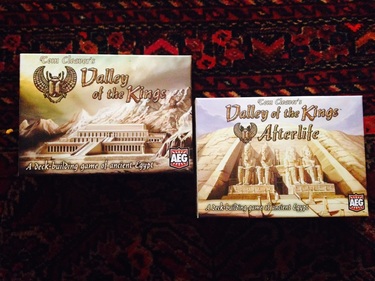 Valley of the Kings and its expansion. Valley of the Kings and its expansion. I have since updated my review of this game! For my most up-to-date thoughts and format, click here. This week I spent a lot of time testing out a little deckbuilder that I got myself for my birthday: Valley of the Kings. It's a game set in ancient Egypt, in which all of the players are pharaohs attempting to stock their tombs for the afterlife. As with your typical deckbuilder, all players begin with the same set of basic cards, which are used to acquire newer and fancier cards from the "pyramid." There are two mechanics that make Valley of the Kings special.The first is that the cards you can acquire are arranged in a pyramid shape, and you can only purchase cards from the bottom row of the pyramid. Every time a card is bought, the pyramid "crumbles" and the cards at the top slowly drift to the bottom. If you want to have a go at cards in the upper rows, you need to use relevant actions on the cards you've already acquired. Pyramid manipulation becomes an important part of the game that can get you what you want, and, in a group, keep coveted items out of the grasp of other players. The second unique mechanic is "entombment." The game is ultimately won by the victory points you earn from entombing cards, particularly multiple cards from the same set. However, once you place a card in your tomb, it is effectively out of the game and you can no longer use it to perform actions or to purchase other cards. Because you need to both play successful turns and stock your tomb, Valley of the Kings demands planning and tough choices. Even the actions on the starter cards are relatively useful, making it hard to part with your stuff as you stock up for the afterlife. For me, the attraction of Valley of the Kings is that it offers a 1–4 person game in a tiny box. It's not as deep as a larger deckbuilder, but it is highly satisfying and relatively quick to play. Although there is not always a strong connection between the action printed on the card and the item depicted on it, the art is highly thematic. The cards feature real images of Egyptian artifacts that took me right back to my college days, when I had a part-time job as a museum guard. (Yes, there were mummies, no, they didn't come alive at night!) As a solo game, Valley of the Kings is fun, but the one-player variant is mainly practice for playing with a group. Solitaire rules are published online and are printed in the expansion, Valley of the Kings: Afterlife. But basically, when you play by yourself, your goal is to achieve a perfect score by entombing one of every card from every set. When playing alone, the game is still fun and challenging, but many of the card actions involve interacting with other players. It can feel like you're missing out when you're by yourself. Playing solo also affects your entombment strategy, because it's easier to just start squirreling away cards with interactive abilities—it's not like you need them, strategically speaking. I don't regret buying Valley of the Kings for solo play because it's quick, amusing, and inexpensive. But if you're looking for a deeper solo deckbuilding experience, I would shell out more money and go for something like Apex Theropod or Legendary: Alien Encounters. I've also played Valley of the Kings in a group of three, and I had a great time with it. It's a light, relaxing game with just enough strategy to keep things interesting. Although I will primarily play Valley of the Kings on my own, it shines more when it's played in a group. The box is so small that I think I'll take it to Rome with me this summer and see if the other Latin teachers get hooked. If they're like me, they'll be suckers for a quick game with an ancient theme. Valley of the Kings may also be a fun introductory deckbuilding game for my students. I hope to test it out with them next week as we wrap up the last of our state finals.
0 Comments
Your comment will be posted after it is approved.
Leave a Reply. |
AuthorMy name is Liz Davidson, and I play solo board games. A lot of solo board games... Archives
August 2021
Categories
All
|
 RSS Feed
RSS Feed